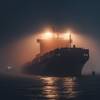Recognizing and Meeting the Challenges of Autonomous Vessels
Uncrewed surface vessels (USVs), automated vessels, maritime autonomous surface ships (MASS), remote controlled vessels, and the employment of artificial intelligence and smart marine technology to navigate and operate civilian and military vessels have created a lively debate over utilizing and regulating such technology. Recent articles addressing artificial intelligence (AI) have questioned the value of experience and intuition versus computed logic based upon data and logarithmic differentiations. What would have happened to flight 1549 if Captain Sully had not used his experience and the plane had been guided purely by AI?
In the 1950s, the authors Isaac Asimov and Ray Bradbury pondered AI. Bradbury, in The Martian Chronicles, described a planet where daily life continued without humans in an AI world. Asimov, in iRobot, confronted the problems and challenges of creating robots to perform dangerous tasks while safely interacting with humans. What, then, are the role and future of USV and MASS? Technology is not new in assisting humans. Artificial intelligence in completely supplanting human judgment is new. However, we are not there, yet.
What is an “autonomous vessel”? 1 U.S.C. 3 describes vessels as “anything that floats.” Autonomous can mean “on its own” or “semi-autonomous” with assistance. This includes everything from drones to vessels with autopilot and critical warning systems. We are an automated society seeking to fully automate vessels, while maintaining ultimate control and determining how to regulate fully automated and/or remote-controlled vessels. Regulatory change and guidelines are being discussed.
Military applications are here
Autonomous vessels are in use by various militaries. On May 25, 2023, the Israeli Aerospace Industries launched The Blue Whale, an autonomous underwater vehicle (AUV). It will be used for naval intelligence and to identify the presence of mines at sea.
Australia has recently announced that it has budgeted $700 million in high-tech naval sea mines and other smart weapons at sea.
For years, the U.S. Navy has been testing drone vessels under its drone boat evaluation program, Ghost Fleet Overlord. The U.S. Navy is focusing on autonomous vessels for use above and below the surface. In February 2023, the USNS. Apalachicola was delivered measuring 337 feet in length with autonomous capabilities to transport troops and to serve as a platform for Osprey aircraft. It can operate autonomously for up to 30 days at sea.
All naval nations have and/or are developing drones and automated vessels. How will the development of AUV and military MASS affect the traditional rules of engagement? On the military side, there is little public discussion. On the commercial side of the development of USV and MASS, the scoping process is well underway.
Commercial use in development
Commercially, automated vessels, fully automated vessels, and remote-controlled vessels are in development. Yahoo Finance reported that in 2022 there was an investment of $3.9 billion in the autonomous ship business. The projected investment by 2030 is $8.2 billion. The emergence of USV and MASS challenges the concepts of marine insurance, limitation of liability statutes, and the Rules of the Road. In March 2023, the USCG released its Unmanned Systems Strategic Plan (USSP) to implement a risk-based approach to develop manning expertise and to collaborate internationally to apply lessons learned. A Maritime Workforce Guidebook was recently introduced during the 2023 Singapore Maritime Week to recognize maritime job redesign to account for the changing needs of automated and remote-controlled vessels.
The International Maritime Organization (IMO) has developed a multinational working group to address safety, legal, and port issues affecting MASS. The IMO has already engaged in scoping exercises to consider how COLREGs may be adapted to MASS. In April, the Joint Working Group met in London. They considered the continuing need for a human Master either onboard or at a remote operations center (ROC). Among continuing discussion is how to license and certify an ROC as Master. Their next meeting is in September, and will include a discussion of port operations.
Every nation is racing toward the world of autonomous shipping. Autonomous shipping is no longer a fictional topic, but a reality. As with any change in technology, the goals are safety and efficiency. The challenge is adapting existing maritime principles where relevant and mutually recognizing and agreeing on new laws and regulations.
As a maritime society, we have progressed from sails to engines, from sextants to satellites, and from parallel rulers to GPS networks setting courses. As technology has advanced, the maritime industry has collaborated and met the challenges of a continuously evolving technological world. The future is here and more is yet to come.











